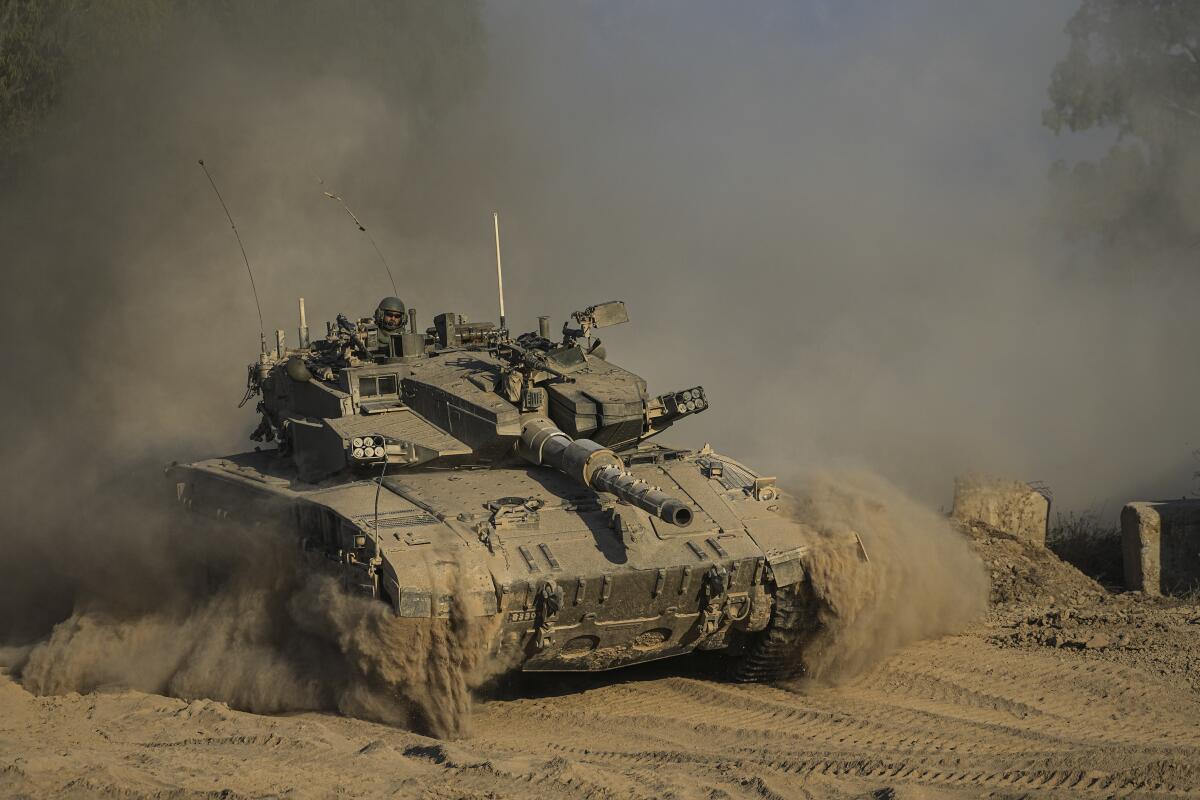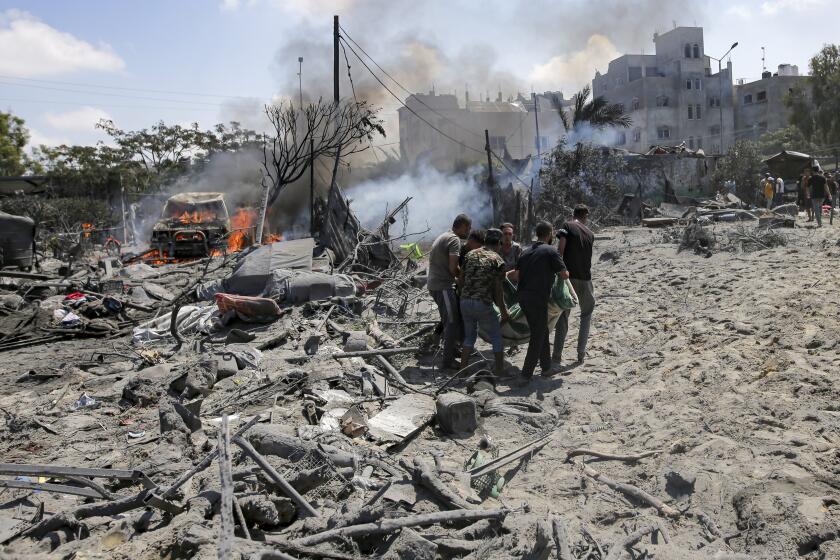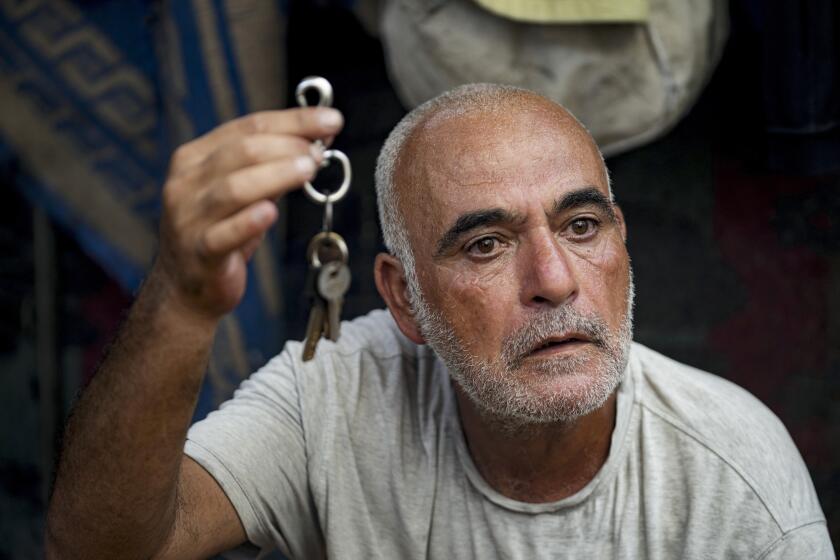Israeli strikes in south, central Gaza kill more than 60, including in ‘safe zone’

DEIR AL BALAH, Gaza Strip — Israeli airstrikes killed more than 60 Palestinians in southern and central Gaza overnight and into Tuesday, including one that struck an Israeli-declared “safe zone” crowded with thousands of displaced people.
Airstrikes in recent days have brought a steady stream of Palestinian deaths in the Gaza Strip, even as Israel has pulled back or scaled down major ground offensives in the north and south. Almost-daily strikes have hit the safe zone covering an estimated 23 square miles along the Mediterranean coast, where Israel told fleeing Palestinians to take refuge to escape ground assaults. Israel has said it is pursuing Hamas militants who are hiding among civilians after offensives uprooted underground tunnel networks.
Tuesday’s deadliest strike hit a main street lined with market stalls outside the southern city of Khan Yunis in Muwasi, at the heart of the zone that is packed with tent camps. Officials at Khan Yunis’ Nasser Hospital said 17 people were killed.
Apparently referring to the strike, the Israeli military said in a statement that it targeted a commander in the militant group Islamic Jihad’s naval unit west of Khan Yunis. It said it was looking into reports that civilians were killed.
Israel says it targeted Hamas’ elusive military commander in a massive strike in southern Gaza that local health officials say killed at least 90 people.
The attack hit about a half a mile from a compound that Israel struck Saturday, saying it was targeting Hamas’ top military commander, Mohammed Deif. That blast, in an area also surrounded by tents, killed more than 90 Palestinians, including children, according to Gaza health officials. It is unknown whether Deif was killed in the strike.
The new airstrikes came as Israel and Hamas continued to weigh the latest cease-fire proposal. Hamas has said talks meant to wind down the nine-month-long war would continue, even after Israel targeted Deif. International mediators are working to push Israel and Hamas toward a deal that would halt the fighting and free about 120 hostages held by the militant group in Gaza.
Israeli forces have repeatedly had to launch new offensives to combat Hamas fighters they say have been regrouping in parts of Gaza that the military previously invaded. Still, the military has sounded increasingly confident that it has severely damaged the militants’ organization and infrastructure in its campaign.
The military said Tuesday that it has eliminated half of the leadership of Hamas’ military wing and that about 14,000 militants have been killed or detained. It said that it killed six brigade commanders, more than 20 battalion commanders and about 150 company commanders from Hamas’ ranks, and that over the course of the war, it has hit 37,000 targets from the air in the Gaza Strip, including more than 25,000 terrorist infrastructure and launch sites.
Hamas says Gaza cease-fire talks continue and the group’s military commander is in good health a day after the Israeli military targeted Mohammed Deif.
The figures could not be independently confirmed.
Israel’s ground campaigns have focused on northern Gaza and the southern cities of Khan Yunis and Rafah, where it says it has destroyed extensive Hamas tunnel networks. The offensives have left entire neighborhoods flattened. Although ground operations continue in Rafah, airstrikes now appear to be hitting heavily in the areas untouched by previous offensives in the territory’s center and the coastal safe zone.
Strikes late Monday and on Tuesday hit the Nuseirat and Zawaida refugee camps in central Gaza. Strikes on four houses killed at least 24 people, including 10 women and four children, according to officials at Al Aqsa hospital in the nearby town of Deir al Balah.
Another hit a United Nations school in Nuseirat where families were sheltering, killing at least nine people. AP video showed the schoolyard covered in rubble and twisted metal from a structure that was hit. Workers carried bodies wrapped in blankets, as women and children watched from the classrooms where they have been living.
Israel’s military said Hamas militants were operating from the school to plan attacks. Its claim could not be independently confirmed.
Other strikes in Khan Yunis and Rafah killed 12 people, according to medical officials and AP journalists. An AP journalist counted the bodies at the hospital before a funeral was held at its gates.
Over nine months of war between Israel and Hamas, Palestinian families in Gaza have been uprooted repeatedly, driven back and forth the territory.
The military said air force planes struck about 40 targets in Gaza over the last day, among them observation posts, Hamas military structures and explosives-rigged buildings. Israel blames Hamas for civilian casualties because the militants operate in densely populated areas.
The Israeli military said Tuesday that it would begin sending draft notices to ultra-Orthodox Jewish men next week — a step that could destabilize Prime Minister Benjamin Netanyahu’s government and trigger more large protests in the community. Under long-standing political arrangements, ultra-Orthodox men had been exempt from the draft, which is compulsory for most Jewish men — an exemption that created resentment among the general public in Israel.
The war in Gaza, which was sparked by Hamas’ Oct. 7 attack in southern Israel, has killed more than 38,600 people, according to the territory’s Health Ministry, which does not distinguish between combatants and civilians in its count. The war has created a humanitarian catastrophe in the coastal Palestinian territory, displaced most of its 2.3 million population and triggered widespread hunger.
Hamas’ October attack killed 1,200 people, mostly civilians, and militants took about 250 hostage. About 120 remain in captivity, with about a third of them believed to be dead, according to Israeli authorities.
Violence has also surged in the West Bank. On Tuesday a Palestinian stabbed an Israeli policeman, wounding him lightly, before another officer opened fire, killing the assailant, who was identified as a 19-year-old from Gaza.
Shurafa writes for the Associated Press.
More to Read
Sign up for Essential California
The most important California stories and recommendations in your inbox every morning.
You may occasionally receive promotional content from the Los Angeles Times.













